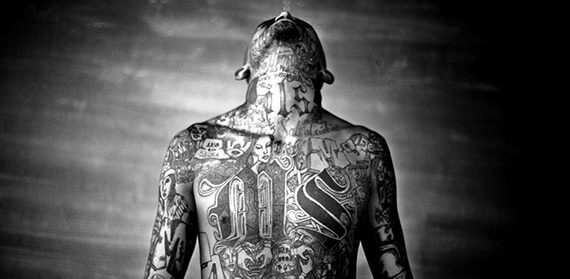Adam Baird is Research Fellow at the Centre for Peace, Trust and Social Relations, Coventry University, UK. 
Dennis Rodgers is Professor of International Development Studies, Department of Geography, Planning and International Development Studies, University of Amsterdam, Netherlands.
Inequality and exclusion powered the rise of Latin American revolutionaries and still afflicts large swathes of society across the region today. These conditions are a primary driver of the contemporary violence that makes Latin America one of the most brutal places to live on Earth.
Gangs are often placed at the forefront of contemporary Latin American violence, with populist rhetoric frequently pigeonholing them as ‘the problem’. Yet studies of gangs across the region – which are surprisingly few and far between – show us that their members are overwhelmingly poor, disenfranchised young men, living in the urban margins. In other words, they are born into chronic inequality, elitism, and exclusion that once gave rise to revolution. While gang members rarely speak of revolution in political terms, if you talk to them it becomes clear that much of their activity is a response to the constraints of exclusion. Without excusing gang violence, it is clear that simply fingering them as ‘irrational criminals’ will do little to help understand them as symptoms of social inequality, a signal of discontent, or even a perverse form of social movement.
Obviously, we should be wary of romanticising gangs with Guevarian fervour, but the parallel becomes apparent when policy responses to gangs are considered. If we look to Central America’s recent history we could argue that one form of warfare has replaced another. Right-wing political violence during wars of the 1970s and 1980s directed by a US-backed elite national minority, gave way to the new right-wing political violence of the infamousMano Dura (‘Firm Hand’) crackdowns against gangs. Despite the fact that Mano Dura has been shown to exacerbate and embed violence, crackdowns continue, partly because of the unacknowledged political role that such policies play, as well as the deep-seated authoritarian institutional cultures, particularly in the security forces.
In recent years a new champion has emerged on the policy block. Citizen Security is a collection of policies and practices to respond to violence and crime suffered by individuals. These policies encompass a diffuse range of initiatives, including ‘technical cooperation’ to reform state institutions in order to help them respond better to individual ‘consumer security needs’, human rights training, as well as measures to improve institutional capacity for collecting and monitoring homicide statistics. As such, Citizen Security projects mark a clear shift from defending state sovereignty against political insurgency or international war towards keeping individual citizens safe. This shift has its roots in a landmark Human Development Report called ‘New Dimensions of Human Security’. This report redefined the intellectual meaning of ‘security’ by focusing on the ‘human’ aspect. It was a telling precursor to the current idea of ‘citizen’ in security, to the extent that nowadays ‘citizen’ and ‘human’ security are considered mutually dependent.
Citizen Security has since expanded in tandem with the crisis of violence in Latin America, but only picked up traction in the 2000s when organisations like the UNDP, WHO, the World Bank, the Inter-American Development Bank, and later the ICRC ran with it. They prompted governments to reform their judiciary and security sectors, and to adopt violence ‘prevention’ interventions that had a developmental, as opposed to punitive, orientation. Whilst reform has been encouraged at an institutional level, funding has also trickled down from the international donor community to a smorgasbord of NGOs and smaller community based organisations. For example, the State Department’s ‘Central American Regional Security Initiative’ (CARSI) has poured $642 million into such initiatives since 2008. Whilst this type of funding is still dwarfed by the USA’s harder, military ‘assistance’ to the region, it is encouraging that security itself has begun to adopt some developmental components.
On the surface it appears to be a paradigm shift in dealing with insecurity and has been welcomed by a raft of scholars and practitioners. At the same time, though, these approaches rarely challenge the political economies of inequality and exclusion that drive most violence. To a large extent this is due to the way that security has been individualized within the Citizen Security paradigm. It is a property, and partly the responsibility, of individual citizens rather than a public good. Gangs provide a useful window onto this. Conceptualising gangs as the problem, rather than as symptomatic of a dystopian context obscures the fact that the principal driver of gang violence is a societal organisation where the relative riches and excitement of gang-life standout to young men as their best or only option to make something of themselves. This does not mean that gang members should not be punished of their crimes nor that aspirations to the rule of law should be abandoned, but it does indicate that lasting solutions will only come from challenging structural systems of exclusion engrained in many Latin American societies.
Policy makers need to understand that security starts at the root of the problem – structural issues such as inequality and exclusion, which are woven into the fabric of society across the region. There is value in focusing on ‘citizen’ safety, but the individualisation of security should not detract us from the critical need for deep social change. This means broadening both our notion of the rule of law and of the ‘good society’ to make them more encompassing, collective, and less focused on the individual. The violence that is often perceived as the main threat to peace, security and democracy in Latin America is arguably not the main problem. If gangs are a perverse outcome of the concentration of wealth, power and the weakness of institutions across the region, then maybe they are less of a threat but rather a signpost to an age-old problem – the one that revolutionaries such as Sandino, Marti, Zapata, and Guevara all highlighted many years ago, but which we have yet to resolve. Seen from this perspective, if we really want to tackle violence and ‘the gang problem’, the solution is clearly not to demonize them but rather to re-think our social, political, and economic models in ways that build more inclusive societies.
Rodgers and Baird explore these issues in more depth in their recent chapter “Understanding gangs in contemporary Latin America”, in Scott H. Decker and David C. Pyrooz (eds.), The Handbook of Gangs, New York: Wiley, also available online on ResearchGate.
Image courtesy of markarinafotos.
Originally featured on ResearchGate




Comments are disabled